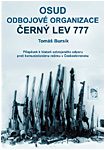Osud odbojové organizace Černý Lev 777 - Příspěvek k historii ozbrojeného odporu proti komunistickéme reïmu v Československu
Fate of the Resistance Organization Black Lion 777 - Contribution to the history of armed resistance against Communist rule in Czechoslovakia
Author(s): Tomáš Bursík
Contributor(s): Svatava Matoušková (Editor), Jana Zoubková (Editor), Hynek Zlatník (Translator), Pavel Chabr (Translator)
Subject(s): Politics / Political Sciences, Politics, History, Recent History (1900 till today), Special Historiographies:, Security and defense, WW II and following years (1940 - 1949), Post-War period (1950 - 1989), History of Communism
Published by: Ústav pro studium totalitních režimů
Keywords: Czechoslovakia; Communist Party; State Security Police; StB; Černý Lev 777; Black Lion 777; joint action; bomb attack; secretariat; Sedlčany; Milevsko; investigation; judicial proceedings; lawsuits;
Summary/Abstract: This study describes the history of Černý lev 777 (“Black Lion 777”), one of the anti-Communist resistance groups in the former Czechoslovakia. The study is based on primary sources including the memories of the sister of one of the executed members of Černý lev 777, and also uses resources containing some characteristics of the more general relationships that relate to the topic of the third resistance in Czechoslovakia. Černý lev 777 proves that there were, and are, people who were not content to remain merely unresponsive victims of the Communist atrocities and decided to act. This meant taking a weapon and responding with adequate steps to combat the Communist totalitarian regime. From this viewpoint, the activities of Černý lev 777 in the broader Czechoslovak context may appear equal to those of, for instance, the Mašín brethren and others. Jiří Řezáč, Jaroslav Sirotek and Bohumil Šíma, the key representatives of Černý lev 777 and their companions responded to the Communist doctrine of class struggle in the same manner and decided to put up an active resistance. Stockpiling weapons, intimidating Communist Party officials, fighting to prevent the collectivisation of village farmsteads and attempting to establish links with foreign intelligence agents were some of the activities Černý lev 777 was involved in. Its greatest acts were the bomb blasts which destroyed the district committee offices of the Communist Party of Czechoslovakia in Sedlčany in July 1949 and in Milevsko in May 1950. It was not until 5 years after the group’s first actions that the members were arrested, at the beginning of July 1954. Besides the members of the anti-Communist organisation, many other people, such as relatives, friends and people who had nothing in common with Černý lev 777, were arrested over a few weeks. Much is already known about the investigation methods of State Security Police (StB) in the first half of the 1950’s: long overnight interrogations, physical and mental stress, falsification of protocols, use of prison informers in the cells of detainees, etc. The three court hearings before the regional court in České Budějovice were merely a formality. They resulted in three death penalties (Jiří Řezáč, Jaroslav Sirotek and Bohumil Šíma) and many other heavy sentences. Many people were arrested for committing crimes which the court never proved. These processes were also used by the Communist propaganda to further intimidate those who refused to approve the so called “people’s democratic establishment”. Those sentenced in the trial of Jiří Řezáč and co. and in the subsequent trials of “František Nygrýn and Co.” and “Vladimír Hřebejk and Co.” passed through many Czechoslovak prison facilities in 1950’s and 1960’s. It was not only themselves but also their families that suffered. They were not fully rehabilitated until the 1990’s.
- Print-ISBN-13: 978-80-254-1125-4
- Page Count: 118
- Publication Year: 2007
- Language: Czech
- eBook-PDF
- Sample-PDF
- Table of Content
- Introduction

